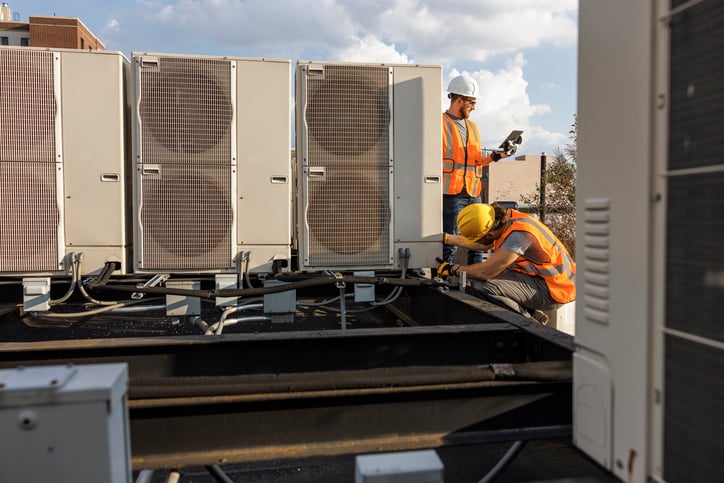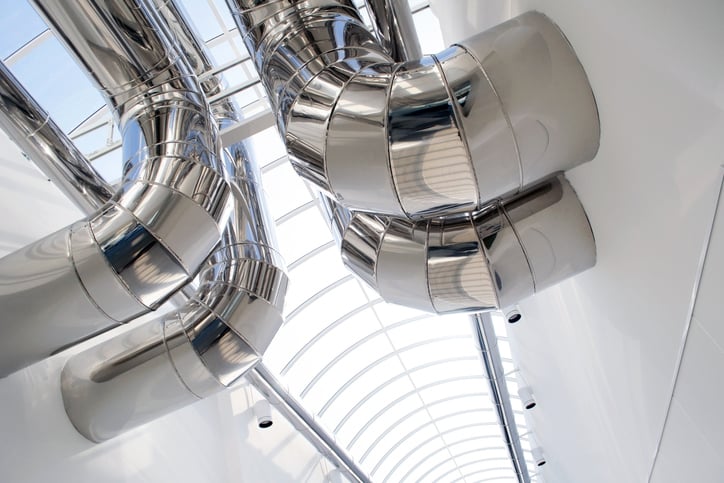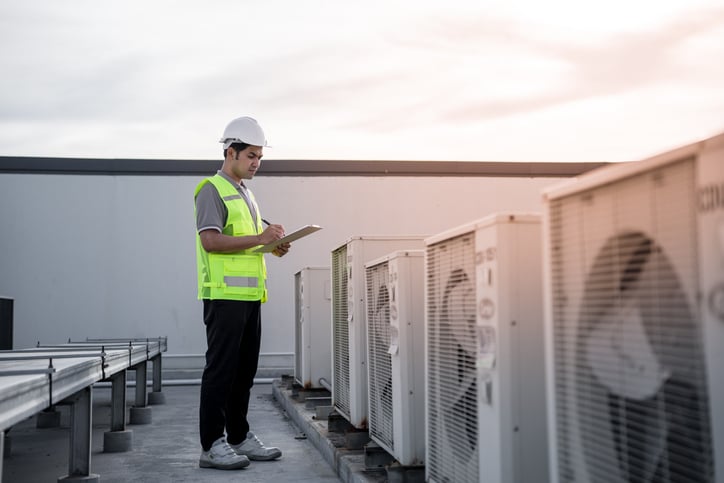A Closer Look at HVAC Sensors: Types, Functions, and Benefits

Consider the car you’re currently driving. Now, think of the car you learned to drive in.
Even if your vehicle now is 10 years old, it’s probably lightyears beyond the car you first took to the streets in. Cars of all sorts now are more sophisticated and responsive to all elements of operation than they’ve ever been.
Still, both vehicles have the same base function: getting you from point A to point B. There are components that will always endure in a vehicle’s design for function but can be upgraded as technology improves.
The story’s the same for HVAC systems. While their primary function hasn’t changed, the systems have become more efficient, intelligent, and adaptable, thanks to advancements in sensor technology and system integration. Today's HVAC systems are designed not just for heating, cooling, and ventilation, but also for optimizing energy use, improving indoor air quality, and enhancing occupant comfort beyond temperature control.
4 Necessary HVAC Sensors for System Design & How They Improve Functionality
While many types of sensors can be integrated into your system that can monitor for or control a wide variety of metrics, there are four base-level sensors your HVAC design should include.
What’s more, each sensor type comes with a choice – using the traditional version or option for an advanced upgrade. Let’s explore each sensor type and the differences between traditional and advanced HVAC monitoring sensors.
- Temperature sensors
- Pressure sensors
- Humidity sensors
- Indoor air quality sensors
1. Temperature Sensors
Typically the first sensor that comes to mind for HVAC as it controls the system's primary function, its role is simple: monitor ambient temperatures and activate the system to keep conditions within a certain range.
HVAC design uses three primary types of temperature sensors for the climate control systems:
- Thermocouples: These HVAC heat sensors measure temperature by creating a voltage that changes with temperature. They are preferred for their wide temperature range and fast response time.
- Resistance Temperature Detectors (RTDs): RTDs operate by changing resistance in a predictable way with temperature changes. This sensor type boasts high accuracy and stability over a wide range.
- Thermistors: This sensor type varies its electrical resistance in response to temperature changes. It offers precise temperature measurement within a limited range.
Traditional HVAC Temperature Sensors Vs. Advanced HVAC Temperature Sensors |
|
|
Traditional temperature sensors in HVAC systems, like thermocouples and RTDs, measure ambient temperature to regulate heating and cooling. These sensors often have slower response times (compared to modern temperature sensors) and may not accurately reflect rapid temperature changes or microclimatic variations in larger spaces. Their limited precision can lead to inefficient energy use, as the system might overheat or overcool areas, impacting both comfort and energy consumption. |
Advanced temperature sensors, including smart and network-connected sensors, have revolutionized HVAC system functionality. These sensors offer faster response times and greater accuracy, enabling more precise climate control. They can adapt to real-time environmental changes, optimizing energy use by adjusting heating and cooling outputs more efficiently. Integrated with IoT technology, they facilitate predictive maintenance and system diagnostics, reducing downtime and prolonging system life. |
2. Pressure Sensors
Though serving a different function and monitoring a different metric, HVAC pressure sensors aren't unlike temperature sensors when it comes to system design for optimized system performance and energy efficiency. These sensors provide essential data for maintaining correct pressure levels in various parts of the system, directly influencing efficiency and functionality. You'll find them throughout the entire system in places such as:
- Air Ducts to ensure balanced air distribution, vital for consistent climate control across different zones.
- Refrigerant Circuits for regulating the refrigeration cycle, crucial for effective cooling and energy efficiency.
- Filters for detecting differential pressure across air filters, these sensors are key in identifying filter blockages, aiding in timely maintenance, and sustaining air quality.
Traditional HVAC Pressure Sensors Vs. Advanced HVAC Pressure Sensors |
|
|
Like traditional HVAC temperature sensors, traditional pressure sensors also often have limited sensitivity and slower response times. This can lead to less efficient airflow control and imprecise refrigerant pressure management, resulting in reduced system efficiency and higher energy consumption. Additionally, their lack of detailed diagnostic capabilities can hinder effective maintenance, potentially leading to increased system stress. |
Advanced HVAC pressure sensors, incorporating digital and smart technologies, significantly enhance system performance and efficiency. These modern sensors provide more accurate and real-time pressure data, allowing for precise control of airflow and refrigerant levels. With better sensitivity and faster response, they optimize system operation, adapting quickly to changes and reducing energy waste. Integrated with IoT systems, these advanced sensors enable predictive maintenance and remote monitoring. |
3. HVAC Humidity Sensors
Measuring the moisture content in the air, HVAC humidity sensors help the system keep airborne moisture levels within a healthy and comfortable range. Proper humidity control is essential not only for comfort but also for preventing health issues and preserving building materials.
There are two main types of humidity sensors used in HVAC systems:
- Capacitive Sensors which measure humidity based on changes in electrical capacitance caused by moisture absorption. Capacitive sensors are generally more cost-effective and are widely used in commercial HVAC systems due to their reliability and precision.
- Resistive Sensors which measure humidity through changes in electrical resistance in a hygroscopic material. While they are simpler and lower in cost, resistive sensors are less accurate than capacitive sensors and can be more susceptible to contamination and long-term drift.
In a sense, humidity sensors help HVAC systems serve double duty. Not only do they keep indoor humidity levels at an acceptable range, but by doing so, they also help prevent mold growth and condensation. Mold can pose significant health risks and damage building structures, while condensation can lead to discomfort and deterioration of indoor surfaces.
Traditional HVAC Humidity Sensors Vs. Advanced HVAC Humidity Sensors |
|
|
While effective for basic humidity control, traditional HVAC humidity sensors can have slow response times and decreased accuracy over time due to sensor contamination or material degradation. This can lead to poor humidity regulation, affecting indoor air quality and occupant comfort. Furthermore, their limited sensitivity and slower recalibration can result in inadequate prevention of mold growth and condensation, potentially leading to health issues and building damage. |
Advanced humidity sensors, leveraging newer technologies, offer significant improvements in HVAC system functionality. These include enhanced capacitive sensors with better accuracy, faster response times, and greater resistance to contamination. They provide more precise and consistent humidity control, essential for optimal indoor air quality and comfort. Integrated with smart HVAC systems, these sensors can dynamically adjust to changes in indoor and outdoor conditions, effectively managing moisture levels. |
4. HVAC Indoor Air Quality Sensors
HVAC indoor air quality (IAQ) sensors are crucial for monitoring and managing the levels of pollutants within indoor environments. And this is a broad category of sensors – it can include CO2 sensors for HVAC, airflow sensors, and even ozone sensors. In a post-pandemic world, this sensor type is getting new attention as its functionality affects how an HVAC system impacts:
- Pollutant Levels: IAQ sensors continuously monitor the concentration of harmful substances like VOCs, CO2, and particulate matter. VOCs can emanate from paints, cleaning supplies, and other building materials, while CO2 levels rise with occupancy. High levels of particulate matter can exacerbate respiratory conditions.
- Health and Productivity: Poor air quality can affect building occupants in a variety of ways, whether it’s becoming sick or simply feeling sluggish. It’s not uncommon for those exposed to poor air to experience symptoms like headaches, dizziness, and fatigue. Effective monitoring and control of air quality can mitigate these health risks.
- Ventilation and Purification Strategies: In a post-pandemic world, the role of IAQ sensors has become more critical than ever. They inform ventilation and air purification strategies, ensuring sufficient air exchange and reducing pathogen spread. Enhanced ventilation and purification, guided by accurate IAQ data, help create safer and healthier indoor environments.
Traditional HVAC Indoor Air Quality Sensors Vs. Advanced HVAC Indoor Air Quality Sensors |
|
|
Traditional indoor air quality sensors in HVAC systems primarily detect basic pollutants like CO2 and larger particulate matter. These sensors often use chemical or optical methods for detection, which can be less sensitive to a broader range of pollutants and may not provide real-time data. Their limited scope in detecting finer particulate matter and a narrow range of VOCs can lead to inadequate air quality control. This shortfall can result in poorer health outcomes and decreased comfort for occupants, as well as less effective ventilation strategies. |
Advanced indoor air quality sensors represent a significant leap in HVAC system functionality. These modern sensors utilize sophisticated technology to detect a wider array of pollutants, including a broad spectrum of VOCs and finer particulate matter, with greater accuracy and in real-time. Integration with smart HVAC systems allows for dynamic adjustments to air quality conditions, ensuring optimal ventilation and air purification. Put simply, advanced sensors contribute to healthier indoor environments, enhanced occupant comfort, and improved overall building sustainability. |
Optimizing HVAC System Design Via Advanced Sensor Technology
Think of an orchestra for a moment – but one that’s not up to snuff.
The string section isn’t tuned and the brass keeps missing its cues. What’s more, the percussion session keeps using the wrong instruments altogether.
What kind of concert reviews do you think it’ll get?
In a sense, HVAC systems aren’t dissimilar.
How’s that?
If all its components aren’t functioning as they should in tandem with one another, you can expect a lackluster performance.
On an individual level, it’s easy to point out how one sensor type’s functionality – or lack thereof – can impact the HVAC system for one metric. But working together, advanced sensor technology (regardless of type) brings a symphonic approach to getting the most from the HVAC system.
Temperature sensors adjust heating and cooling to match desired settings, while humidity sensors maintain moisture levels for comfort and health. Air quality sensors detect pollutants, ensuring clean air, and pressure sensors maintain optimal airflow and system performance. When these sensors operate in concert, they not only optimize energy use but also ensure a consistently comfortable and healthy indoor environment.
Optimizing a building’s HVAC with advanced sensor technology isn’t about simply adding more sensors to the system. There’s a science of sorts to HVAC advanced sensor integration for the best system performance possible. For instance, with HVAC temperature location, this means considering factors such as the layout of the space, occupancy patterns, and external environmental influences. With this level of integration, HVAC systems can adapt in real-time to changing conditions, maintaining optimal air quality and comfort while maximizing energy efficiency.
Bring Advanced Sensor Technology to Your HVAC System Design
Ready to upgrade your HVAC system in one of the easiest ways? Speak with one of our HVAC sensor engineers!




